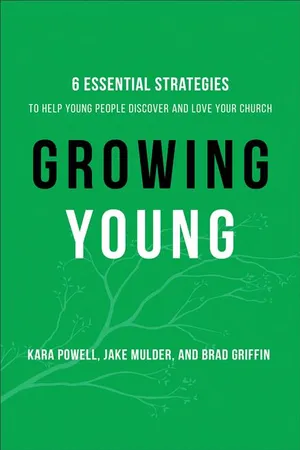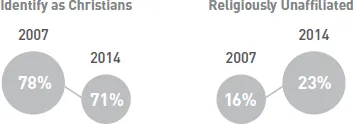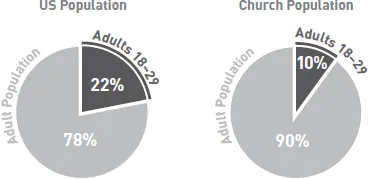
eBook - ePub
Growing Young
Six Essential Strategies to Help Young People Discover and Love Your Church
- 336 pages
- English
- ePUB (mobile friendly)
- Available on iOS & Android
eBook - ePub
Growing Young
Six Essential Strategies to Help Young People Discover and Love Your Church
About this book
All churches grow old. Strategic churches grow young.
Churches are losing both members and vitality as increasing numbers of young people disengage. Based on groundbreaking research with over 250 of the nation's leading congregations, Growing Young provides a strategy any church can use to involve and retain teenagers and young adults.
This strategy includes six core commitments for growing young:
● Unlock keychain leadership
● Empathize with today's young people
● Take Jesus' message seriously
● Fuel a warm community
● Prioritize young people (and families) everywhere
● Be the best neighbors
Growing Young also profiles innovative churches that are engaging 15- to 29-year-olds and as a result are growing--spiritually, emotionally, missionally, and numerically.
Packed with both research and practical ideas, this book shows pastors and ministry leaders how to position their churches to engage younger generations in a way that breathes vitality, life, and energy into the whole church.
Churches are losing both members and vitality as increasing numbers of young people disengage. Based on groundbreaking research with over 250 of the nation's leading congregations, Growing Young provides a strategy any church can use to involve and retain teenagers and young adults.
This strategy includes six core commitments for growing young:
● Unlock keychain leadership
● Empathize with today's young people
● Take Jesus' message seriously
● Fuel a warm community
● Prioritize young people (and families) everywhere
● Be the best neighbors
Growing Young also profiles innovative churches that are engaging 15- to 29-year-olds and as a result are growing--spiritually, emotionally, missionally, and numerically.
Packed with both research and practical ideas, this book shows pastors and ministry leaders how to position their churches to engage younger generations in a way that breathes vitality, life, and energy into the whole church.
Frequently asked questions
Yes, you can cancel anytime from the Subscription tab in your account settings on the Perlego website. Your subscription will stay active until the end of your current billing period. Learn how to cancel your subscription.
No, books cannot be downloaded as external files, such as PDFs, for use outside of Perlego. However, you can download books within the Perlego app for offline reading on mobile or tablet. Learn more here.
Perlego offers two plans: Essential and Complete
- Essential is ideal for learners and professionals who enjoy exploring a wide range of subjects. Access the Essential Library with 800,000+ trusted titles and best-sellers across business, personal growth, and the humanities. Includes unlimited reading time and Standard Read Aloud voice.
- Complete: Perfect for advanced learners and researchers needing full, unrestricted access. Unlock 1.4M+ books across hundreds of subjects, including academic and specialized titles. The Complete Plan also includes advanced features like Premium Read Aloud and Research Assistant.
We are an online textbook subscription service, where you can get access to an entire online library for less than the price of a single book per month. With over 1 million books across 1000+ topics, we’ve got you covered! Learn more here.
Look out for the read-aloud symbol on your next book to see if you can listen to it. The read-aloud tool reads text aloud for you, highlighting the text as it is being read. You can pause it, speed it up and slow it down. Learn more here.
Yes! You can use the Perlego app on both iOS or Android devices to read anytime, anywhere — even offline. Perfect for commutes or when you’re on the go.
Please note we cannot support devices running on iOS 13 and Android 7 or earlier. Learn more about using the app.
Please note we cannot support devices running on iOS 13 and Android 7 or earlier. Learn more about using the app.
Yes, you can access Growing Young by Kara Powell,Jake Mulder,Brad Griffin in PDF and/or ePUB format, as well as other popular books in Theology & Religion & Christian Church. We have over one million books available in our catalogue for you to explore.
Information
1. Growing Young
What Congregations Are Doing Right
A lot of my friends don’t really want to go to their church. But we want to be here, and the older people in our church can see that . . . so they want us to be here. Our whole church treats us like we’re the church of today, not just the church of the future.
—Ashlee, age 17
Growing old is our default. It happens naturally. And inevitably.
We see the results of growing old when we look in the mirror.
We see the effects of growing old when we look around our congregations.
With age comes great wisdom and beauty. Decades of burrowing in the love and grace of Jesus give the mature members of our faith communities a network of deep roots. Year after year, season after season, their ongoing commitment to love God and others yields a rich harvest.
Old isn’t bad. We love old. We just don’t think it’s the whole story.
If your church is like many, you have bare spots. Holes created by the teenagers and young adults missing from your congregation. You see them on Friday night at the local movie theater and Saturday morning at the neighborhood coffeehouse, but they are absent from your Sunday morning worship services. These bare spots make your church feel incomplete.
Maybe your congregation’s bare spots represent more than just missing young people. Perhaps across generations your church isn’t growing as you wish. You may be a senior leader trying to hide your disappointment as you stand to preach and think to yourself, “Where is everyone?” Or you’re a church member noticing it’s now easier to find a preferred parking space before your worship services. Regardless of your role, your church’s energy and attendance aren’t what they used to be or what you would hope.
Those of you who are part of a growing church likely wish it was growing faster. And yet with that growth, you still want your congregation to feel close and intimate. You are thrilled with the new faces, but you don’t want to lose the relational glue that drew you all together in the first place.
Or perhaps you are blessed to be in a congregation bursting with young people. You love how the Spirit is drawing them. But you want to make sure that they don’t merely consume what you offer. You want them to be unleashed to join—and help lead—God’s redemptive work in the world.
The truth is, every church needs young people. Their passion enriches the soil around them. The curiosity they bring to Scripture and the authenticity they bring to relationships keep your church’s teaching fresh and fellowship fruitful.
Young people also need a thriving church. A thriving church both grounds them in community and sends them out to serve.
Your church needs young people, and they need your church. One without the other is incomplete.
The Alarming Reality of Congregations in America
If you’re wondering why your congregation is aging, shrinking, or plateauing, you’re not alone. Almost weekly, someone at Fuller Theological Seminary quotes this powerful axiom from beloved senior trustee Max De Pree: “The first job of a leader is to define reality.”1 The unfortunate reality is that most churches are not growing, and they aren’t getting any younger.
Church Attendance Is Declining
According to an extensive survey by the Pew Research Center, the share of adults in the US who identify as Christians fell from 78 percent to 71 percent between 2007 and 2014. The corresponding increase in those who identify as “religiously unaffiliated” (meaning atheist, agnostic, or “nothing in particular”) jumped by almost seven points, from just over 16 percent to 23 percent.2
This well-publicized “Rise of the Nones” varies by denomination. Mainline Protestantism, including the United Methodist Church, the American Baptist Churches USA, the Evangelical Lutheran Church in America, the Presbyterian Church (USA), and the Episcopal Church, has experienced the greatest dip in numbers. From 2007 to 2014, mainline Protestant adults slid from 41 million to 36 million, a decline of approximately 5 million.
RELIGIOUS AFFILIATION IN AMERICA 2007–2014

Roman Catholic adults fell from 54 million to 51 million, a drop of nearly 3 million.
Adults in evangelical denominations (such as the Southern Baptist Convention, the Assemblies of God, Churches of Christ, the Lutheran Church–Missouri Synod, and the Presbyterian Church in America), as well as adults in nondenominational churches with evangelical leanings, grew from 60 million to 62 million. While that might seem like something to celebrate, we should hold our kudos. Although the total number of evangelicals has increased, the percentage of Americans who identify as evangelicals has actually decreased almost 1 percent from just over 26 percent to just over 25 percent.
Even though these shifts represent major downturns in three of our nation’s largest Christian traditions, not all denominations are experiencing a slump. Historically black Protestant denominations, such as the National Baptist Convention, the Church of God in Christ, the African Methodist Episcopal Church, and the Progressive Baptist Congregation, remain relatively stable at almost 16 million adults.3
To summarize, no major Christian tradition is growing in the US today.4 A few denominations are managing to hold steady, but that’s as good as it gets.
Congregations Are Aging
Those who study demographics believe the decline in overall church attendance is linked with young people’s religious practices, or lack thereof. According to 2015 US Census Bureau data, adults ages 18 to 29 comprised 22 percent of the adult population. Yet that same age group represents less than 10 percent of church attendees nationwide. Evangelical Protestant congregations have the highest concentration of young adults at 14 percent, followed by Catholic parishes at 10 percent, and mainline Protestant congregations at 6 percent.5
The last handful of years has brought major changes to the faith of young Latinos, one of the fastest-growing ethnicities in the US. From 2010 to 2013, the number of 18- to 29-year-old Latinos who identified as Roman Catholics dropped from 60 percent to 45 percent, while those who identified as “religiously unaffiliated” skyrocketed from 14 percent to 31 percent.6
Another fast-growing group in the US, Asian Americans, is experiencing its own faith struggles. While the “Rise of the Nones” cuts across ethnicities, Asian Americans are 7 percent more likely to be “religiously unaffiliated” than the general population.7
Across cultures, a major turning point for young people’s faith seems to be high school graduation. Multiple studies highlight that 40 to 50 percent of youth group seniors—like the young people in your church—drift from God and the faith community after they graduate from high school.8
YOUNG ADULTS AGES 18–29 AS A PERCENTAGE OF OVERALL POPULATION

“Right now, in this season, we have a youth group that is very centered on going outside of our doors. These students are taking our congregation back to the type of service in our community that helped our church get started. They are breathing fresh air into our church and lighting our passion again. They are modeling for older generations what it means to be a light and glorify God.” —Colette,9 age 27
Let’s make that statistic a bit more personal. Visualize a photograph of the young people in your congregation. Now imagine holding a red pen and drawing an X through almost 50 percent of their faces. That many will fall away from the faith as young adults.10
Some—perhaps more than half—of those who drift from the church end up rejoining the faith community, generally when they get married and have children.11 But that leaves close to 50 percent still adrift. Even those who return have made significant life decisions about worldview, relationships, and vocation—all during an era when their faith was shoved aside. The consequences of those lasting decisions are often tough to erase.
As followers of Jesus, parents, and leaders who have been in student and pastoral ministry much of our adult lives, we aren’t satisfied with the shrinking and aging of congregations. We bet you aren’t either.
From Bare Spots to “Bright Spots”
Thankfully, the news for the church is not all gloom and doom. Despite the cloudy sky, light is breaking through here and there. Our team calls these “bright spots.”12
All around the country, these hundreds of “bright spot” congregations are effectively loving and serving young people. Some of them quietly and without flash. Others with great magnetism and fanfare. We call these churches that grow young because
1. they are engaging young people ages 15 to 29; and
2. they are growing—spiritually, emotionally, missionally, and sometimes also numerically.
Thanks to these remarkable congregations, tens of thousands of young people can’t stop talking about how “known” they feel in their church and how, no matter what happens, their church feels like “home.”
Like the 1,000-member Presbyterian church on the East Coast that developed a long-term high school ministry team that pours into volunteer adult leaders, who in turn build a web of support around students.
Or the 100-member midwestern rural Reformed church that has become so hospitable to teenagers a...
Table of contents
- Cover
- Title Page
- Copyright Page
- Endorsements
- Dedication
- Contents
- Acknowledgments
- 1. Growing Young
- 2. Unlock Keychain Leadership
- 3. Empathize with Today’s Young People
- 4. Take Jesus’ Message Seriously
- 5. Fuel a Warm Community
- 6. Prioritize Young People (and Families) Everywhere
- 7. Be the Best Neighbors
- 8. Growing Young in Your Context
- Appendix
- Notes
- About the Authors
- Back Ads
- Back Cover